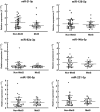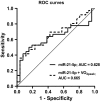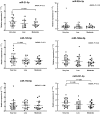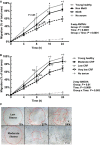Circulating microRNAs and endothelial cell migration rate are associated with metabolic syndrome and fitness level in postmenopausal African American women
- PMID: 31347282
- PMCID: PMC6658676
- DOI: 10.14814/phy2.14173
Circulating microRNAs and endothelial cell migration rate are associated with metabolic syndrome and fitness level in postmenopausal African American women
Abstract
Postmenopausal African American women are at elevated risk for metabolic syndrome (MetS), which predisposes them to cardiovascular disease and other chronic diseases. Circulating microRNAs (ci-miR) are potential mediators of cardiometabolic diseases also impacted by cardiorespiratory fitness (CRF) level. Using real-time quantitative PCR, we compared the expression of vascular-related ci-miRs (miR-21-5p, miR-92a-3p, miR-126-5p, miR-146a-5p, miR-150-5p, miR-221-3p) in sedentary, overweight/obese, postmenopausal African American women based on 1) presence (n = 31) or absence (n = 42) of MetS and 2) CRF level (VO2peak ) (Very Low < 18.0 mL·kg-1 ·min-1 [n = 31], Low = 18.0-22.0 mL·kg-1 ·min-1 [n = 24], or Moderate >22.0 mL·kg-1 ·min-1 [n = 18]). Endothelial migration rate in response to subjects' serum was assessed to determine the effect of circulating blood-borne factors on endothelial repair. Ci-miR-21-5p was the only ci-miR that differed between women with MetS compared to those without MetS (0.93 ± 0.43 vs. 1.28 ± 0.71, P = 0.03). There were borderline significant differences (P = 0.06-0.09) in ci-miR-21-5p, 126-5p, and 221-3p levels between the CRF groups, and these three ci-miRs correlated with VO2peak (r = -0.25 to -0.28, P < 0.05). Endothelial migration rate was impaired in response to serum from women with MetS compared to those without after 16-24 h. Serum from women with Moderate CRF induced greater endothelial migration than the Very Low and Low CRF groups after 4 and 16-24 h, that was also not different from a young, healthy reference group. Ci-miR-21-5p is lower in postmenopausal African American women with MetS, while ci-miRs-21-5p, 126-5p, and 221-3p are associated with CRF. Factors which impair endothelial cell migration rate are present in serum of women with MetS, though having Moderate CRF may be protective.
Keywords: Cardiorespiratory fitness; circulating microRNA; endothelium; menopause; metabolic syndrome.
© 2019 The Authors. Physiological Reports published by Wiley Periodicals, Inc. on behalf of The Physiological Society and the American Physiological Society.
Conflict of interest statement
No conflicts of interest, financial or otherwise, are declared by the authors.
Figures





Similar articles
-
Whole-Body Cryotherapy Alters Circulating MicroRNA Profile in Postmenopausal Women.J Clin Med. 2023 Aug 12;12(16):5265. doi: 10.3390/jcm12165265. J Clin Med. 2023. PMID: 37629307 Free PMC article.
-
Atherosclerotic Conditions Promote the Packaging of Functional MicroRNA-92a-3p Into Endothelial Microvesicles.Circ Res. 2019 Feb 15;124(4):575-587. doi: 10.1161/CIRCRESAHA.118.314010. Circ Res. 2019. PMID: 30582459
-
Evaluation of Vascular Endothelial Function in Young and Middle-Aged Women with Respect to a History of Pregnancy, Pregnancy-Related Complications, Classical Cardiovascular Risk Factors, and Epigenetics.Int J Mol Sci. 2020 Jan 9;21(2):430. doi: 10.3390/ijms21020430. Int J Mol Sci. 2020. PMID: 31936594 Free PMC article.
-
Metabolic syndrome and its components in premenopausal and postmenopausal women: a comprehensive systematic review and meta-analysis on observational studies.Menopause. 2018 Oct;25(10):1155-1164. doi: 10.1097/GME.0000000000001136. Menopause. 2018. PMID: 29787477
-
Association between circulating microRNAs and the metabolic syndrome in adult populations: A systematic review.Diabetes Metab Syndr. 2022 Jan;16(1):102376. doi: 10.1016/j.dsx.2021.102376. Epub 2021 Dec 20. Diabetes Metab Syndr. 2022. PMID: 34954485
Cited by
-
The role of microRNAs in pathophysiology and diagnostics of metabolic complications in obstructive sleep apnea patients.Front Mol Neurosci. 2023 Jul 21;16:1208886. doi: 10.3389/fnmol.2023.1208886. eCollection 2023. Front Mol Neurosci. 2023. PMID: 37547923 Free PMC article. Review.
-
Circulating MicroRNA Profiling in Non-ST Elevated Coronary Artery Syndrome Highlights Genomic Associations with Serial Platelet Reactivity Measurements.Sci Rep. 2020 Apr 10;10(1):6169. doi: 10.1038/s41598-020-63263-6. Sci Rep. 2020. PMID: 32277149 Free PMC article.
-
Exosomal Secretion of Adipose Tissue during Various Physiological States.Pharm Res. 2020 Oct 15;37(11):221. doi: 10.1007/s11095-020-02941-6. Pharm Res. 2020. PMID: 33063193 Free PMC article. Review.
-
Acute response in circulating microRNAs following a single bout of short-sprint and heavy strength training in well-trained cyclists.Front Physiol. 2024 Mar 12;15:1365357. doi: 10.3389/fphys.2024.1365357. eCollection 2024. Front Physiol. 2024. PMID: 38532845 Free PMC article.
-
Sex-specific alterations in blood-borne factors in physically inactive individuals are detrimental to endothelial cell functions.J Appl Physiol (1985). 2020 Oct 1;129(4):664-674. doi: 10.1152/japplphysiol.00292.2020. Epub 2020 Jul 30. J Appl Physiol (1985). 2020. PMID: 32730175 Free PMC article.
References
-
- Ahirwar, A. K. , Jain A., Singh A., Goswami B., Bhatnagar M. K., and Bhatacharjee J.. 2015. The study of markers of endothelial dysfunction in metabolic syndrome. Horm. Mol. Biol. Clin. Invest. 24:131–136. - PubMed
-
- Bär, C. , Thum T., and de Gonzalo‐Calvo D.. 2019. Circulating miRNAs as mediators in cell‐to‐cell communication. Epigenomics 11:111–113. - PubMed
Publication types
MeSH terms
Substances
LinkOut - more resources
Full Text Sources
Medical
Miscellaneous

